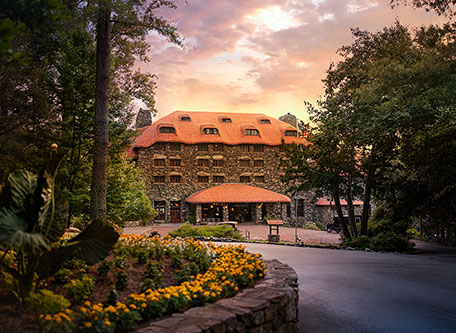Receive for Free - Discover & Explore eNewsletter monthly with advance notice of special offers, packages, and insider savings from 10% - 30% off Best Available Rates at selected hotels.
golf
Discover Omni Grove Park Inn Golf Course, which was renovated by Donald Ross during the Roaring Twenties.
Omni Grove Park Inn’s amazing, par-70 Grove Park Golf Course clears a bright green path of 6,400 yards through the rolling hills of the Blue Ridge Mountains. Elevated points give players spectacular views of the mountains and the magnificent Arts and Crafts-style historic hotel. The historic course is described as the “only rival” to Pinehurst in a state ranking of Donald Ross courses by Visit NC. The course opened for play around the time the inn first debuted, and it was beautifully redesigned by Scottish golf course architect Donald Ross in 1926. Ross was a Scottish-born immigrant who trained as a young man with the great Old Tom Morris at St Andrews during the 1890s. He then spent the majority of his career and life in the United States, where he designed many of the world’s championship courses during the “Golden Age of Golf.” Ross specifically built dozens of iconic fairways throughout the country, including Aronimink Golf Club, Seminole Golf Club, the Oak Hill Country Club, and Pinehurst No. 2. His influence still exists today on the historic courses he designed, as well as the newer ones that he inspired. Several years after it opened, the championship-caliber Grove Park Golf Course was a stop on PGA Tours between 1933 and 1951. It has even been played by PGA stars Bobby Jones, Ben Hogan, and Jack Nicklaus. Former President Barack Obama has even played a round on the course, who was also just one of ten U.S. presidents to stay at the resort throughout its history. The Grove Park course was updated in 2001 and retains master-designer Donald Ross’s vision, feel, and look. It has since earned praise from Conde Nast Traveler (Top 20 Southern U.S. Golf Resorts in 2011) and North Carolina Golf Panel (Top 100 Golf Courses in the State). This historic course has even consistently been acknowledged as one of the Top Resort Golf Courses in North Carolina by Golfweek Magazine.
-
About the Location +
Omni Grove Park Inn is located in the quaint community of Asheville, North Carolina. A town steeped in history, Asheville features over 100 different locations that the U.S. Secretary of the Interior has listed on its National Register of Historic Places. The Omni Grove Park Inn is mere moments away from the Grove Park Historic District—a neighborhood recognized for its immense architectural diversity. Composed of some 290 buildings, the area was once a planned suburban community designed by Chauncey Beadle just prior to the outbreak of World War I. At the time, Beadle was known all over North America for his landscaping talents, having created countless parks and gardens across the southern United States. Most of the historic structures display different varieties of Colonial Revival, Tudor Revival, and Bungalow-style architecture. The Grove Park Inn is also close to many more celebrated historic sites, too, including the Thomas Wolfe Memorial, the Historic Greenwood Village, and the Montford Area Historic District.
Perhaps the greatest of these cultural landmarks is the Biltmore Estate. Constructed by the Vanderbilt family during the 1890s, the destination is a beautiful Gilded-Age mansion that is also the largest privately-owned house in the United States. The project had specifically been commissioned by George Washington Vanderbilt II, who was a prominent railroad and steamboat magnate during the late 19th century. Architect Richard Morris Hunt designed the structure to resemble a gorgeous French chateau, while the great Frederick Law Olmstead landscaped the 8,000 acres that surrounded the mansion. Measuring 178,926 sq. ft., Vanderbilt required a massive workforce to tend to the building. To facilitate such a large body of employees, he constructed the “Biltmore Village,” which had been known at the time as “Best.” The nucleus of this community still exists today, sitting adjacent to the mansion’s main entrance. The Biltmore Estate is now listed on the U.S. National Register of Historic Places and is recognized by the federal government as a National Historic Landmark. Despite its status as a private residence, the mansion is open to tours for the general public.
Asheville itself resides at the western edge of North Carolina’s Blue Ridge Mountains, and is just a short drive away from Pisgah National Forest and the Eastern Band of Cherokee Indians. The city dates to a small frontier settlement founded by John Burton during the 1790s. Burton decided to name the community as “Morristown,” in honor of American patriot Robert Morris. But Morristown was renamed “Asheville” after North Carolina’s governor, Samuel Ashe, when the state legislature chartered it in 1797. Asheville gradually became a major center for manufacturing in western North Carolina during the 1800s, in which the arrival of railroads facilitated the growth of factories throughout the community. Textile mills became a common sight in Asheville, as were plants that processed various raw materials. This economic growth slowed considerably due to the Great Depression, when most of the local banks went bankrupt. The silver lining to the calamity was that many of the historic buildings in downtown Asheville remained untouched, leaving the city with one of the largest collections of original Art Deco structures in the entire country. Asheville today has undergone a cultural renaissance and is a favorite destination for travelers eager to explore the surrounding mountainous terrain.
-
About the Architect +
Donald Ross: Few other golf course designers have had such an impact on the sport of golf than the legendary architect Donald Ross. Born in Dornoch, Scotland, Ross’ legendary career began when he apprenticed under Old Tom Morris at historic St. Andrews during the late 1890s. He harnessed several important skills from Morris that ranged from club maintenance to landscaping. Ross then used his education to parlay a job at the Royal Dornoch Golf Club near his childhood home. Unfortunately for Ross, the pay was abysmal. With the encouragement of Scottish expat named Robert W. Willson, Ross decided to try to find more rewarding work at one of the many new professional golf facilities that had started opening across the United States. Willson subsequently financed Ross’ trip across the Atlantic in 1899, who helped him settle down just outside of Boston, Massachusetts. Ross accepted a job as the resident golf pro at the Oakley Country Club, where he left an immediate impression upon its members. Word soon spread of his talents, which eventually attracted the attention of prominent businessperson James Walker Tufts. In the midst of developing the resort town “Pinehurst” within the North Carolina sandhills, Tufts decided to hire Ross to head the new settlement’s golf club. Ross headed south that winter, although not without some cajoling from friends who doubted the entire endeavor.
Nevertheless, Ross went to work in 1901, serving as the primary golf instructor for a single, 18-hole course created a few years prior by Dr. Leroy Culver and John Dunn Tucker. Ross decided to completely renovate its fairways after conferring with Tufts, thus jumpstarting the work on the future Pinehurst No(s). 1 – 4 over the next two decades. Over time, they quickly became the treasures that Tufts had originally envisioned. Their success further catapulted Ross’ reputation throughout the United States, inspiring many other destinations to hire him to design their respective courses. In all, Ross would create (and redesign) over 400 unique golf courses across the country, with some of his most notable being at the Seminole Golf Club, Oak Hill Country Club, and the Aronimink Golf Club. Ross was also commissioned to renovate the brilliant 18-hole golf course at The Omni Grove Park Inn in 1926. He subsequently transformed the layout into a stunning system of unique fairways that blended in seamlessly into the surrounding countryside. Ross continued to work well into his seniority, often returning to Pinehurst to modify his first four professionally made courses. When he finally died in 1948, he had managed to leave a legacy that few others in the world of golf have come close to matching ever since. In fact, Ross’ legacy is still so great today that the World Golf Hall of Fame even inducted him posthumously several decades later in 1979.
-
Famous Historic Golfers +
Bobby Jones, winner of 13 golf championships that include the U.S. Open and the British Open.
Ben Hogan, winner of nine major golf championships that include his famous “Triple Crown” season.
Jack Nicklaus, winner of 18 major golf championships—the most of any professional golfer.
Barack Obama, 44th President of the United States (2009 – 2017)
































